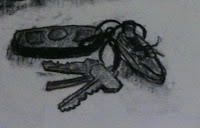While I drew and colored extensively as a small child, ever since I taught myself how to paint in 4th grade, I have primarily focused on this form of art. For me, the appeal of painting was that I could blend colors and create realistic gradients in a way that is far more difficult to draw. Also, when I really began painting, I was primarily producing art on useful objects as gifts for other people. As such, wooden boxes and picture frames lent themselves to being painted. In high school, while I did take a variety of courses including the 3-term pre-req studio course, drawing, printmaking, and a 3D seminar; I spent the most time (3 semesters) in various levels of painting courses. During my senior year, I was often incredibly impressed by the work of my peers who had chosen to focus on drawing and since then, I have felt the need to develop my own ability to draw. I believe that taking this class has sharpened and refined my not only my drawing skills but also my overarching capability as an artist.

As he reviewed my work at the beginning of the term, professor Fick asked if I was a painter as he felt I had a “painterly” style. As he has mentioned my style a few times during the term, I have wondered how my approach to drawing has made my style painterly. Is it the various techniques that I tend to use to apply and blend the medium? Are my drawings “looser” or less focused on clean, geometric lines? For such large-scale drawings, I prefer to use charcoal because it produces a much greater range of values. Subtle changes in shading that can be produced with graphite are better suited for small, detailed work, in my opinion. Also, given the relative size of a graphite stick or pencil, it is rather impractical to cover large areas that need dark values especially compared to using a stick of pressed charcoal. I prefer to spend time and effort working on focal points of my drawing rather than working in endless crosshatching to get a dark area (especially when it is a background or rather unimportant element). Charcoal is also much easier to blend to create subtle shading and gradients without harsh lines that graphite can leave behind. I believe that my preference of charcoal with regard to blending, shading, and the ability to cover large areas, has quite a bit to do with the fact that I also paint. When I searched “drawing” and scanned the Wikipedia page, I read through the list of mediums/instruments: “graphite pencils, pen and ink, inked brushes, wax color pencils,crayons, charcoal, chalk, pastels, markers, styluses, and various metals”. Reading through just this list makes one start to wonder: where is the line between drawing and painting? Oil pastels can easily be smeared and blended on the page in the same way that paint could. Why are inked brushes considered a drawing instrument rather than a painting instrument? If there are encaustic wax paints and wax pencils, what makes one for drawing and the other for painting? It seems to me that drawing and painting are actually part of a continuum; however in academic settings, we focus on very different aspects of the “separate” principals.
* * * * * * *
As an artist, I am very focused on the meaning, narrative, or theme of a piece as I work. When Professor Fick mentioned that we should try to include some sort of quirky or nearly surprising elements into our early still life drawings, I was excited to include something subtle but perhaps amusing to a careful viewer.

I arranged this still life to reflect my enjoyment and involvement in sailing. I grew up boating with my family, but my father’s intense passion for sailing has inspired my own love for the sport. Recently I’ve sailed on a wooden schooner from Boston up to Nova Scotia and back as a student crew member (2007;Ocean Classroom program), I was the Vice President of the Duke Sailing team for a year and a half, and spent this past summer working as a sailing instructor at a girls’ overnight camp in Vermont.

The still life includes items that I would take to go out to sailing practice: my very broken-in, boating Sperry Top-Siders, a small canvas bag, Duke Sailing shades, and my car keys. The careful viewer will notice my mini Sperry key chain.
Chart describing "Drawing Development in Children"
No comments:
Post a Comment